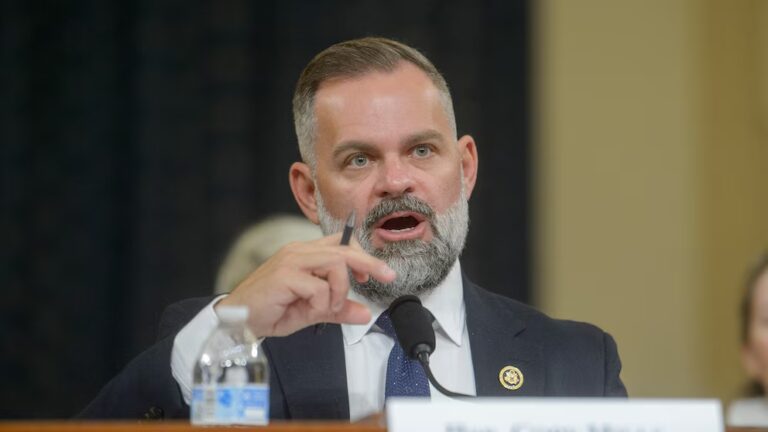
Over the past few years, America saw its murder rate rise — in 2015, 2016, and, according to the most recent data, the first half of 2017. Meanwhile, an opioid epidemic has led to the deadliest drug overdose crisis in US history — with nearly 64,000 drug overdose deaths in 2016 (at least two-thirds of which were linked to opioids), up more than 20 percent from the more than 52,000 drug overdose deaths in 2015.
Now, a prominent criminal justice expert says that these two crises may be related.
The connection isn’t totally obvious at first glance. Drug and opioid overdoses have been increasing for decades, while the recent increase in the murder rate has been going on for only a few years (following a decades-long drop in murder and violent crime in general across America). So how can the decades-old opioid epidemic cause part of the only years-long rise in murders?
The potential answer, according to Richard Rosenfeld of the University of Missouri in St. Louis, is a recent shift in the opioid crisis.
For much of the epidemic, the big cause of the rise in overdose deaths was opioid painkillers. These opioids were first obtained legally, with a doctor prescribing them and a pharmacy dispensing the drugs. They could be and often were diverted — by teens rummaging through their parents’ medicine cabinets, by patients giving or selling the pills to others, and so on — but generally, the drugs were initially prescribed to a patient. Until 2015, the biggest cause of drug overdose deaths was prescribed painkillers.
Recently, however, the opioid epidemic began to shift toward illicit drugs. Starting around 2011, opioid painkiller overdose deaths began to level off, and heroin overdose deaths began to increase. Then, starting in 2014, illicit fentanyl overdose deaths began to skyrocket — to the point that synthetic opioids like fentanyl are now linked to more overdoses than any other drug, including opioid painkillers.
It’s this transition to the illicit market that Rosenfeld says may have helped cause a rise in murders: Since illegal drug markets tend to be much more violent than legal drug markets, the greater use of illicit opioids came with more violence.
“As demand for illicit drugs increases, people enter the underground drug market to purchase the drug,” Rosenfeld told me. “Those underground markets tend to be relatively volatile and sometimes violent places, so I’m suggesting that what we’re seeing here is a spike in drug-related homicides associated with drug transactions that become violent.”
The theory gets at a big gap in our knowledge: We just don’t know why the murder rate spiked, according to FBI data, by 11 percent in 2015, 8 percent in 2016, and 1.5 percent in the first half of 2017 after a decades-long decline. The opioid crisis may provide part of, although not all of, the answer.
Although he cautions that it’s preliminary, Rosenfeld has unearthed some data that backs up this possibility. If true, it has big implications: The opioid epidemic is already the deadliest drug overdose crisis in US history. That the crisis also might be tied to a rise in murders is alarming.
Why there might be a link between the opioid epidemic and murders
Crime rates are expected to fluctuate over time for all sorts of reasons, such as changes in the overall age composition leading to more or less young people — who tend to be more violent than their older counterparts — in the general population. But sometimes, big spikes in crime can only be explained by sudden events, which social scientists call an “exogenous shock.” So what was the exogenous shock that led to an increase in murders in 2015, 2016, and through mid-2017?
The most prominent theory has been the “Ferguson effect.” One version of this theory, put out by conservative columnist Heather Mac Donald, claims that Black Lives Matter protests over the police — particularly those that began in Ferguson, Missouri, after the 2014 police shooting of Michael Brown — led officers to stop proactive policing, hindering their ability to prevent crime and emboldening criminals.
The other version of the Ferguson effect, which Rosenfeld argues is more plausible, suggests that the attention to police shootings and Black Lives Matter protests have heightened long-simmering distrust in police, particularly within minority communities. This distrust can, based on the research, lead to more crime, since it makes people much less likely to cooperate with the police and more likely to instead deal with interpersonal conflicts through their own, sometimes violent means.
Rosenfeld doesn’t rule out the Ferguson effect as an explanation for part of the rise in murders. But he noticed a curious statistic in a 2017 study: In 2015, the white homicide victimization rate rose by 8.2 percent.
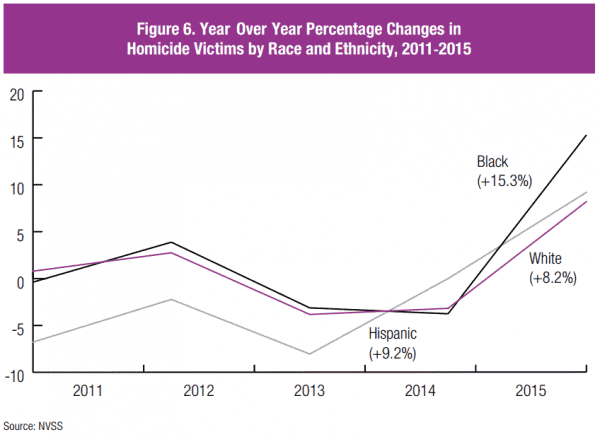

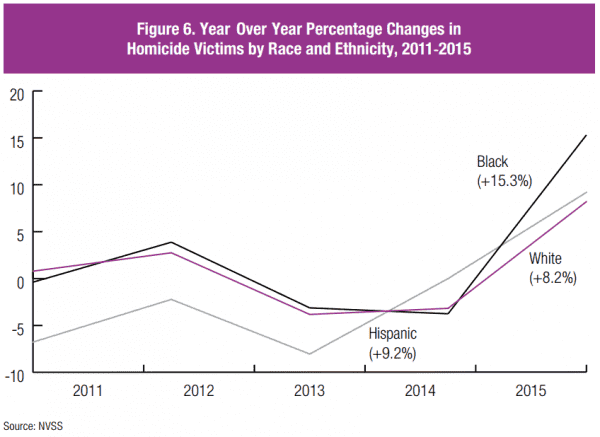
“That increase among whites is really quite notable,” Rosenfeld said. “It’s the largest single-year percentage increase in white homicides, with the exception of the 2001 terrorist attack, since the early 1990s.”
The Ferguson effect can’t really explain this increase. The theory, as Mac Donald has explained it, typically focuses on depolicing in minority, urban areas — where police have long practiced disproportionately aggressive approaches. And the Ferguson effect, as the Rosenfeld version of the theory goes, really speaks to increases in black and brown Americans’ distrust in the police — after all, Gallup surveys show that white people’s confidence in the police was up in 2015 through 2017 compared to 2012 through 2014, while it was down among Hispanic and black respondents.
Rosenfeld argued that the opioid epidemic can help explain the increase. Although the epidemic has spread to black communities in recent years, the crisis has in general hit white communities much harder. In 2016, for example, the white drug overdose death rate was 21.7 per 100,000 people, while the black overdose death rate was 16.4 per 100,000. So if the opioid crisis is causing a rise in murders, you’d expect to see that rise mainly in white communities.
Meanwhile, other data surfaced by Rosenfeld shows that drug-related homicides are significantly up. While other kinds of homicides increased by between 3 and 5 percent in 2015, drug-related homicides — meaning killings linked to drug crimes — increased by more than 21 percent that same year.
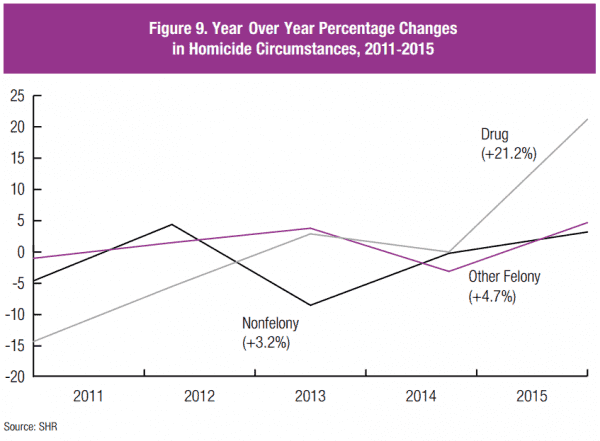

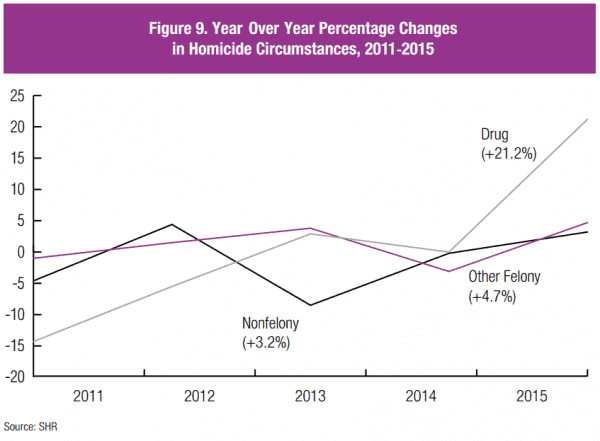
The statistics aren’t perfect. They are based on police finding out that a homicide was linked to a drug crime and inputting that into a system. This leaves a lot of room for human error, which, Rosenfeld acknowledged, likely means that the number of drug-related homicides from year to year is an underestimate.
Still, Rosenfeld said that a sudden shift in the numbers can be used to gauge a trend — and for 2015, the numbers suggest drug-related homicides went way up.
The key to the new potential trend could be the recent shift in the opioid crisis to illicit drug markets for heroin and fentanyl.
There’s a straightforward reason, Rosenfeld said, for why growth in illicit drug use leads to more murders: “When people disagree over price or purity, or when sellers disagree over location or source of supply, those disagreements quite obviously can’t be settled by the courts or the Better Business Bureau or the police.” So these disputes are often settled with violence.
This is similar to what America saw as the crack cocaine epidemic fueled illicit drug markets, although that previous crisis contributed to a much higher murder rate than what we see today.
To summarize: Since the increase in the white homicide rate likely can’t be explained by the Ferguson effect, something else — some other exogenous shock — might be playing a role. The opioid crisis, with its recent shift to the illicit market for heroin and fentanyl and the increase in drug-related homicides, could be to blame.
Rosenfeld is still conducting research into this theory, and he said he will release more of his findings later this month. He repeatedly described his work as preliminary — a launching point rather than a definitive conclusion.
“There’s a lot we don’t know,” Rosenfeld conceded, complaining about how long it takes for the federal government to release national data on crime or overdoses. But he said that the theory is worth mulling over — since it could suggest that the opioid crisis has even further reaching effects than originally thought.
Even if the link is real, it doesn’t justify a “tough on crime” crackdown
In response to Rosenfeld’s research, some policymakers may be tempted to respond with a “tough on crime” crackdown — one that emphasizes locking up drug users and traffickers for exorbitant periods of time — like the one America deployed during the crack cocaine epidemic. But Rosenfeld cautioned against that.
“I have not abandoned a public health framework for addressing this [opioid] crisis,” Rosenfeld said. “I would have promoted a public health framework — in fact, I did — during the crack cocaine era. I think that’s the best way to approach a drug epidemic.”
But, he added, “I also think it’s important when there appear to be criminal justice consequences to the growth of drug use of a particular type, that we need to point them out. But the idea that we return to a war on drugs and a highly punitive approach to people who are addicted to opiates and opioids? I certainly do not favor that.”
After all, Rosenfeld said, a public health framework — one that relies on getting people into addiction treatment so they stop using drugs — “would, in turn, at least from my perspective, shrink demand, and that would settle the markets. They would not expand to the rates they are, and we wouldn’t have as much violence.”
Other research in this area shows that tougher penalties for drugs are ineffective for reducing drug use. A 2014 review of the research by Peter Reuter at the University of Maryland and Harold Pollack at the University of Chicago found that while simply prohibiting drugs to some extent does raise their prices (and therefore makes them less accessible), there’s no good evidence that tougher punishments or harsher supply-elimination efforts do a better job of driving down access to drugs and substance misuse than lighter penalties. So increasing the severity of the punishment doesn’t do much, if anything, to slow the flow of drugs.
That’s why drug policy and addiction experts emphasize the need for more addiction treatment in response to the opioid epidemic. With opioids, there are very effective treatments in medications like methadone and buprenorphine — which have the support of the Centers for Disease Control and Prevention, National Institute on Drug Abuse, and World Health Organization, and studies show can cut all-cause mortality among opioid addiction patients by half or more.
But treatment remains inaccessible. According to a 2016 report by the surgeon general, just 10 percent of Americans with a drug use disorder obtain specialty treatment — in large part due to a lack of supply in care. And other data shows that even when drug addiction treatment is available, fewer than half of facilities offer medications like methadone and buprenorphine as an option.
If treatment was more available, it would help reduce demand for illicit opioids. With that, the number of customers for illicit opioids would shrink — and the illicit market would therefore dwindle as well. That would then reduce the violence attached to the illicit markets, according to Rosenfeld.
So the opioid epidemic may be contributing to a rise in murders. But, in Rosenfeld’s telling, that doesn’t justify a new “tough on crime” response to the crisis; it, in fact, bolsters the argument for moving quickly to significantly boost access to addiction treatment.
Sourse: vox.com
